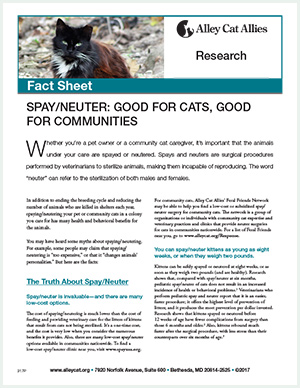Whether you’re a pet owner or a feral cat caregiver, it’s important that the animals under your care are spayed or neutered. Spays and neuters are surgical procedures performed by veterinarians to sterilize animals, making them incapable of reproducing. The word “neuter” can refer to the sterilization of both males and females.
In addition to ending the breeding cycle and reducing the number of animals who are killed in shelters each year, spaying/neutering your pet or community cats in a colony you care for has many health and behavioral benefits for the animals.
You may have heard some myths about spaying/neutering. For example, some people may claim that spaying/ neutering is “too expensive,” or that it “changes animals’ personalities.” But here are the facts:
The Truth About Spay/Neuter
Spay/neuter is invaluableand there are many low-cost options.
The cost of spaying/neutering is much lower than the cost of feeding and providing veterinary care for the litters of kittens that result from cats not being sterilized. It’s a one-time cost, and the cost is very low when you consider the numerous benefits it provides. Also, there are many low-cost spay/neuter options available in communities nationwide. To find a low-cost spay/neuter clinic near you, click here.
For community cats, Alley Cat Allies’ Feral Friends Network may be able to help you find a low-cost or subsidized spay/neuter surgery for community cats. The network is a group of organizations or individuals with community cat expertise and veterinary practices and clinics that provide neuter surgeries for cats in communities nationwide. For a list of Feral Friends near you, go to here.
You can spay/neuter kittens as young as eight weeks, or when they weigh two pounds.
Kittens can be safely spayed or neutered at eight weeks, or as soon as they weigh two pounds (and are healthy). Research shows that, compared with spay/neuter at six months, pediatric spay/neuter of cats does not result in an increased incidence of health or behavioral problems. Veterinarians who perform pediatric spay and neuter report that it is an easier, faster procedure; it offers the highest level of prevention of litters; and it produces the most prevention per dollar invested. Research shows that kittens spayed or neutered before 12 weeks of age have fewer complications from surgery than those 6 months and older. Also, kittens rebound much faster after the surgical procedure, with less stress than their counterparts over six months of age.
All cats should be spayed/neutered, even if you think they’ll never be around other cats.
Even if you think that your cat will never be around other cats, it is important that she is sterilized to improve her health and prevent mating behaviors. For example, intact male cats tend to roam, fight, and yowl, but a powerful benefit of neutering is that it ends these behaviors. Neutered males are much less likely to run away in search of a mate. If your intact male escapes, he can easily impregnate multiple female cats before you’re able to find him. Females who are not spayed go into heat, which can be very uncomfortable and anxiety-causing for both the cats themselves and for the people who care for them. Females in heat may spray, become agitated and restless, and meow loudly and incessantly.
Spaying/neutering also has important health benefits. For example, intact cats have seven times the risk of developing breast cancer when they get older, compared with the risk for spayed cats. Spaying/neutering also prevents testicular tumors and uterine cancer and uterine infections.
It’s critical to spay/neuter every cat in your care, whether they are male or female, indoor or outdoor.
Female cats should be spayed before their first heat.
Female cats are actually much healthier if they are spayed prior to their first heat cycle. The Association of Shelter Veterinarians’ guidelines recommend neutering before cats reach sexual maturity. Even young cats who have been in heat only once have a significantly higher risk of developing mammary cancer than do cats who are spayed before going into heat. And spaying females before their first heat completely prevents uterine infections and uterine cancer.
Cats do not need to experience motherhood.
Animals do not reproduce because they want tothey get pregnant because their hormones tell them to. Once they are spayed, they no longer go into heat and no longer have the urge to mate. In addition, spaying female cats before their first heat has significant health benefits.
Cats’ behavior is changed for the better when they are spayed/neutered.
Spaying/neutering only reduces or ends the behaviors that you don’t want. Neutered males are much less likely to fight, roam, yowl, or spray urine to mark their territory. Spaying females stops them from going into heat and can make them less anxious. For community cats, neutered males continue to hold their territory and can still spray urine to mark their territory if they feel it is being threatened.
Spaying/neutering does not change an animal’s basic personality, and cats do not have any sort of identity crisis over being sterilized.
Spaying/neutering does not cause cats to gain weightexcessive food and lack of exercise cause animals to gain weight.
After being sterilized, cats may require fewer calories to maintain a healthy weight. This can actually be beneficial for community cats. If you notice that your pet cat is becoming overweight, whether they are sterilized or not, it is important that you make appropriate changes to their diet, and consult with your veterinarian as needed.
It’s important to spay/neuter cats even if you think you could find good homes for any kittens they would have if they were not sterilized.
Even if you can find a good, loving home for every kitten, it still means that there will be fewer homes for the animals in shelters and rescue organizations. If each of the people ready to give a home to one of your pet’s offspring would instead adopt from a shelter or rescue group, many lives could be saved.
Children do not need to see a cat have kittens to understand birth.
It’s much better to teach children about responsible animal caregiving and the importance of spay/neuter. If you want your children to be able to play with kittens, you can volunteer with a local animal rescue group or become a cat foster parent.
Wanting more cats just like yours is not a reason not to spay/neuter your pet.
It’s very unlikely that your pet’s kittens will be just like your pet. In fact, the kittens may receive your pet’s worst traits instead of her best traits. Plus, if you are looking to add a new pet to your family, there are many animals in shelters and rescues waiting for lifelong homes.
Spaying/Neutering Community Cats
For community cats, sterilizing all cats in a colony through Trap-Neuter-Return (TNR) is crucial.
TNR is the only effective and humane approach to community cats. It involves humanely trapping the cats, taking them to a veterinarian to be vaccinated, neutered, and eartipped (while under anesthesia, the tip of the cat’s left ear is removed to indicate that they are neutered), and then returning them to their outdoor home. Ending the cats’ breeding cycles will allow them to live out their natural lives without having to worry about the constant stress of pregnancies and mating. Plus, TNR doesn’t cause colonies to disappear overnightthe cats live out their natural lifespans and the colonies slowly decline in population over years.
Studies confirm that once TNR stops reproduction and mating behaviors, the cats’ relationship with residents improves. Colonies become quieter as behaviors like yowling and fighting stop, calls to authorities about the cats decrease significantly, and community morale improves.8 In a 2002 study conducted by prominent researcher Julie Levy, DVM, community cat caregivers reported that cats tended to roam less after neutering, which is beneficial for their safety and reduces conflict with neighbors.
With decreased competition for mating, the cats are also less likely to suffer injuries. A study of a feral cat colony in London conducted by leading cat biologists and TNR pioneers Dr. Jenny Remfry and Peter Neville found that cats were more affectionate toward each other after neutering, spending more time in groups and fighting less.
Community cats can usually be returned to their outdoor home within 24 hours after surgery.
After the surgery, the cats need a temperature-controlled, safe place to recover and should be monitored closely. If you don’t have a place to keep the cats while they recover, the cats may be able to stay at the spay/neuter clinic for recovery, or you can network with other caregivers to find someone who has ample room to hold the cats during recovery. To network with members of our Feral Friends Network, request a list of members in your area here.
Male cats and often females can be returned to the trapping site 12 to 24 hours following surgery, as long as they are fully awake and do not require further medical attention. In some cases, females may need 48 hours of recovery, depending on their specific circumstances. Caregivers may return nursing mothers as soon as possible, once they completely regain consciousness so they can get back to their kittens. Make sure all cats are fully conscious, clear-eyed, and alert before release. For a step-by-step list of what to do post-surgery, go here.


